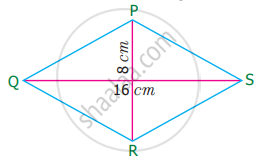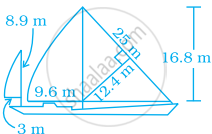Advertisements
Advertisements
Question
The perimeter of a rhombus is 40 cm. If one diagonal is 16 cm; find:
- It's other diagonal
- area
Solution
(i)
Perimeter of rhombus = 40 cm
Perimeter of rhombus = 4 × side
4 × side = 40
side = `40/4 = 10` cm
One diagonal = 16 cm
Diagonals of a rhombus bisect each other at right angles.

OB = `sqrt("AB"^2 - "OA"^2)`
= `sqrt((10)^2 - (8)^2)`
= `sqrt(100 - 64)`
= `sqrt(36)`
= 6 cm
∴ diagonal BD = `6 xx 2 = 12` cm
(ii)
Area of rhombus = `1/2 xx "product of diagonals"`
= `1/2 xx 12 xx 16`
= 96 cm2
∴ (i) 12 cm (ii) 96 cm2
APPEARS IN
RELATED QUESTIONS
The diagonals of a rhombus are 18 cm and 24 cm. Find:
(i) its area ;
(ii) length of its sides.
(iii) its perimeter
Find the area of rhombus PQRS shown in the following figure.
Find the area of a rhombus whose base is 14 cm and height is 9 cm.
Find the missing value.
| Diagonal (d1) | Diagonal (d2) | Area |
| 12 mm | 180 sq.mm |
The area of the rhombus when both diagonals measuring 8 cm is
The height of the rhombus whose area 96 sq.m and side 24 m is
A man has to build a rhombus shaped swimming pool. One of the diagonal is 13 m and the other is twice the first one. Then find the area of the swimming pool and also find the cost of cementing the floor at the rate of ₹ 15 per sq.cm
If the diagonals of a rhombus get doubled, then the area of the rhombus becomes ______ its original area.
The area of a rectangular field is 48 m2 and one of its sides is 6 m. How long will a lady take to cross the field diagonally at the rate of 20 m/minute?
Most of the sailboats have two sails, the jib and the mainsail. Assume that the sails are triangles. Find the total area of sail of the sailboats to the nearest tenth.

